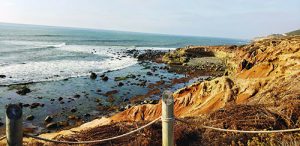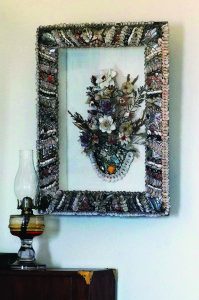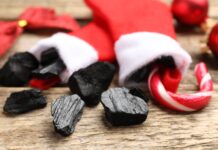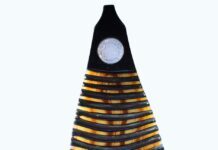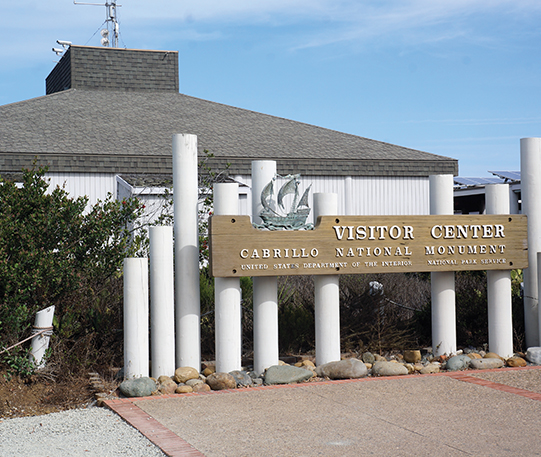
By Helen Serras-Herman
Cabrillo National Monument is located at the furthest southern tip of Point Loma Peninsula in San Diego, California. The site commemorates the landing of Spanish explorer Juan Rodríguez Cabrillo in San Diego Bay.
As I shared in the October 2020 issue of Rock & Gem, my husband and I visited San Diego in November of 2019. One of our first stops was to re-visit Cabrillo National Monument. Hidden away in the park are some wonderful shell art treasures, but first, let me share the Monument’s chronicle and natural history.
Cabrillo’s Voyage
Juan Rodríguez Cabrillo was the captain of the first recorded European voyage to land in San Diego Bay – named San Miguel- on September 28, 1542. He had set sail on June 27, 1542, with three vessels – the San Salvador, Victoria, and San Miguel, and about 250 men to explore the Americas’ uncharted Pacific coast. Sailing north from Navidad in Mexico, he hoped to find a passageway to the Atlantic or the coastal route to the Spice Islands (Moluccas) and Asia’s riches. At that time, no one had any idea of the vast expanse of the Pacific Ocean.
On April 14, 1543, Cabrillo’s ships returned to Navidad without finding gold treasure, exotic spices, or the trade route to Asia. The expedition was considered a failure. However, they returned with something even more valuable, which is the first recorded account of California’s people, places, and climate.
Cabrillo National Monument
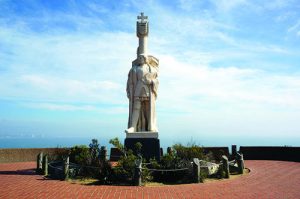
This monument was designated as a California Historical Landmark in 1932 and listed on the National Register of Historic Places in 1966. The visitor’s center has a wonderful Age of Exploration exhibit about Cabrillo’s excursion, detailing the voyage, ships, and the Native American people that Cabrillo encountered. Three excellent films continuously play in the museum’s auditorium, In Search of Cabrillo, On the Edge of Land and Sea, and First Breath: Gray Whales. We watched all of them, and they were educational and compelling.
Also on site is a heroic statue of Cabrillo. The figure stands against a background with a panoramic view of San Diego’s harbor and skyline, and the expanse of the Pacific Ocean. The Portuguese government commissioned the original statue, which was made by sculptor Alvaro de Bree in sandstone in 1939. Unfortunately, the statue was stored for a few years and then suffered severe weathering as it stood exposed to the elements. A replica made of limestone replaced the sandstone figure in 1988.
The Rocky Intertidal Zone
The park where the Cabrillo National Monument sits is also home to one of the most thriving and diverse animal communities – the rocky intertidal zone, where marine plants and animals live. The word intertidal refers to the unique ecosystem existing between the high and low tides along the shore. Tidepools are depressions where water becomes trapped during low tides.
Species that live in the tidepools are coralline algae, chitons, limpets, barnacles, mussels, hermit shore crabs, spongy dead man’s fingers, bat stars, surf grass, and sea hare, among others. This marine habitat is open to the public, with the recommendation that visitors explore and experience, but walk gently and not handle or remove anything.
A variety of shells species also reside in the intertidal zone. Among the species are the wavy turban snail (Turbo fluctuosus), a sea snail with an ovate-conic shape, and conic spire in light olive-green to brown and white colors. Also in residence is the chestnut cowrie (Neobernaya spadicea), a highly glossy shell with caramel color and a dark border, and chitons that are marine mollusks with a shell composed of eight separate plates.
Old Point Loma Lighthouse & the Shell Art Treasures
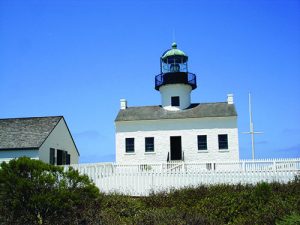
The fascinating shell art treasures referenced at the beginning of the article were almost hidden away inside the assistant keeper’s quarters of the old Point Loma Lighthouse. The lighthouse is one of the earliest U.S. Government lighthouses on the Pacific Coast. Built in 1854, it is now part of Cabrillo National Monument. The main lighthouse building with a protruding tower from the center houses the keeper’s dwelling and the lighthouse system, the 1822-invented Fresnel lens. That ingenious system of glass prisms and bull’s eye lenses collects light rays and forms them into a single powerful beam.
The lighthouse keepers’ duties were to keep the oil lamp burning from sunset to sunrise, clean the lenses, attend to maintenance, and conduct any necessary repairs. The work was continuous, besides living isolated. The last lighthouse keeper was Robert D. Israel, along with his wife, Maria. They lived at the lighthouse for almost 20 years, from 1871 to 1891, raising their family. Maria’s family was one of the earliest settlers of San Diego. Maria raised their sons, and for three years, she also served as assistant keeper (The Old Point Loma Lighthouse, 2007, Cabrillo National Monument Foundation).
During her free time, Maria Isreal created beautiful and intricate floral designs with a treasured wealth of shells that her children collected from the tidepool area. Many of the shells were chitons, wavy turban snails, chestnut cowrie, and broken abalone shells. She made her charming creations and set them into wooden frames. Two of these elaborate artworks hang on the wall of the parlor in the assistant keeper’s house. The large oval artwork is above the fireplace mantel and the other on a wall. Maria also used her husband’s small paintings as centerpieces and surrounded them with her shell artwork. Also on the mantel are small jewelry-style wooden boxes decorated with shells. She sometimes sold her pieces to lighthouse visitors.
Unfortunately, the room is closed off with a rope, so visitors can only stand at the
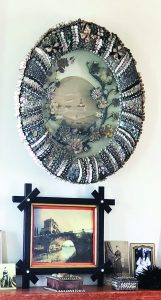
doorstep without being able to get close to these shell art pieces. Thankfully I read about them in the park’s brochure and went searching for them. Had I not, I would probably not have noticed them, and they are a product of time, patience, and creativity woven together with nature’s shell treasures.
First pieces of shell art, or shellwork as it is often referred to, appeared in the 17th century on boxes and caskets, and by the 18th century and the 19th-century Victorian era, shellwork became a popular craft.
Today, many artists, especially those living close to the ocean, create beautiful shell art. Some shells are left in their natural colors, while others are brightly painted. Many of these artworks are individual shells painted decoratively, while others are ornate, complex pieces, with an assortment of shells and rocks assembled in creative designs.
Cabrillo National Monument (https://www.nps.gov/cabr/index.htm ) is open daily from 9 a.m. to 5 p.m, and the admission fee is $20 per vehicle, but all National Park passes are honored.


